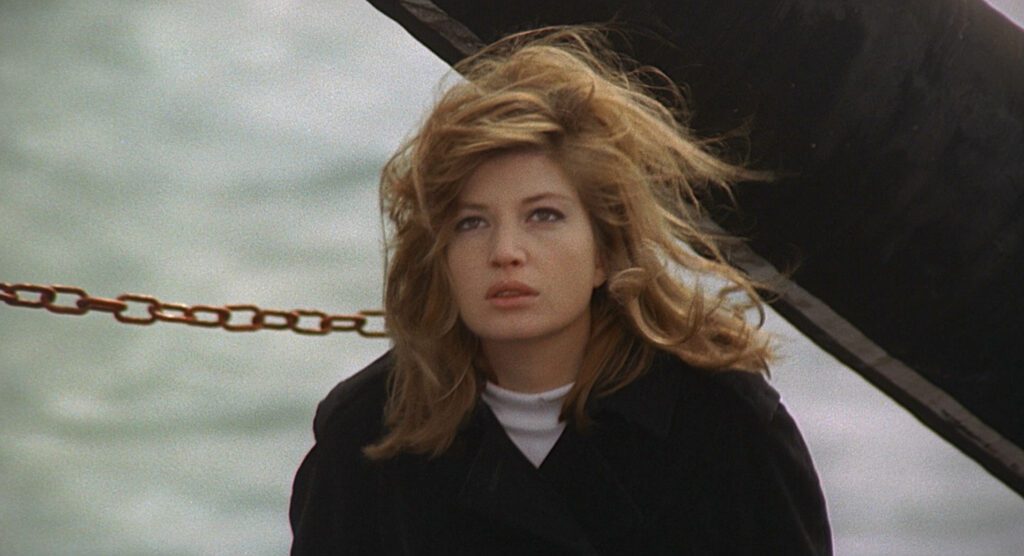
Red Desert
1964, directed by Michelangelo Antonioni
It’s ironic that Red Desert is set in Ravenna, one of Europe’s oldest cities, famous for its Byzantine architecture and once capital of the Roman Empire. In contrast to Ravenna’s historical image, the setting is thoroughly modern, almost to the extent of looking like a science fiction movie. Giuliana and Ugo live in a futuristic house, and their son Valerio plays with a toy robot, a gyroscope, and a chemical set. The characters inhabit a world of factories, ships, and offshore platforms, and they travel to a radio antenna where scientists try to communicate with extraterrestrial civilizations.
Even the way of life is modern. There’s no sign of religion, and marital bonds are no longer sacred. The married couples at the quayside cabin are drawn into a circle of free love. Max brings his wife Linda, but he’s more interested in Mili; Mili is attracted to Corrado; Corrado flirts with Giuliana; Giuliana wants her husband Ugo; and Ugo’s hands and eyes are all over Linda. On one hand the modern world is upside-down and out of tune with nature… smokestacks spew out poisons, companies tear men from their families to work halfway across the world, and ships carry contagious diseases from foreign lands. On the other hand the film finds a hypnotic beauty in the colors and forms of the industrial landscape, and the electronic music score attests to the attraction of modernity. Red Desert recognizes the disruptive force of the modern world, but it’s far from being a protest against it.
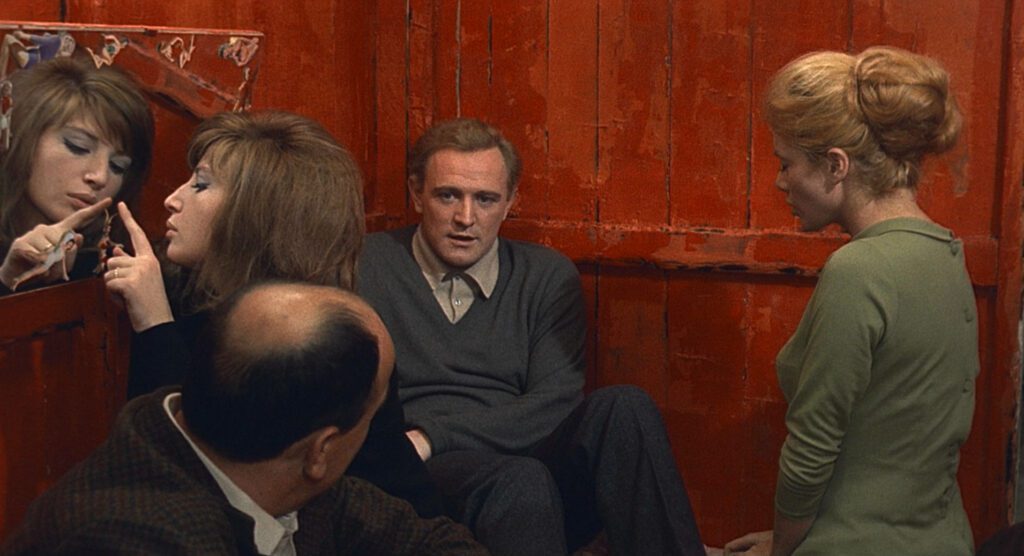
The paradox of the modern industrial world is that although its purpose is to prolong and enhance human life, it has developed so fast that many individuals do not readily adapt to it. Compared to traditional societies that evolved over centuries to accommodate the multiplicity of humanity, it’s like a rough draft of some as yet unrealized advanced world that everyone can find a place in.
Giuliana embodies this difficulty of adjustment. Since a recent car accident (an automobile being a fitting token of modernity) her behavior and emotions have been erratic. In the aftermath she had lost interest in her husband and child, and she tried killing herself. Her symptoms may be consistent with psychotic depression or some anxiety disorder, but the film is not concerned with a clinical diagnosis.
The blurred images of the chemical plant in the opening shots are one of many visual expressions of Giuliana’s difficulty grasping her world. Her confusion comes in waves, and the photography teeters between abstraction and representation as reality dissolves and reasserts itself. Shifts in frame or focus turn familiar sights into abstract color images before resolving back again. In one episode Giuliana’s companions fade into a fog bank as her panic intensifies. The backgrounds go blurry several times, even right before the end. It’s ambiguous how far Giuliana progresses toward a recovery, but the film’s concern is not psychological – it’s metaphysical, and Giuliana ultimately arrives at a better understanding of reality. Red Desert, like most of Antonioni’s films, is a lesson in seeing. It begins out of focus and ends in focus.
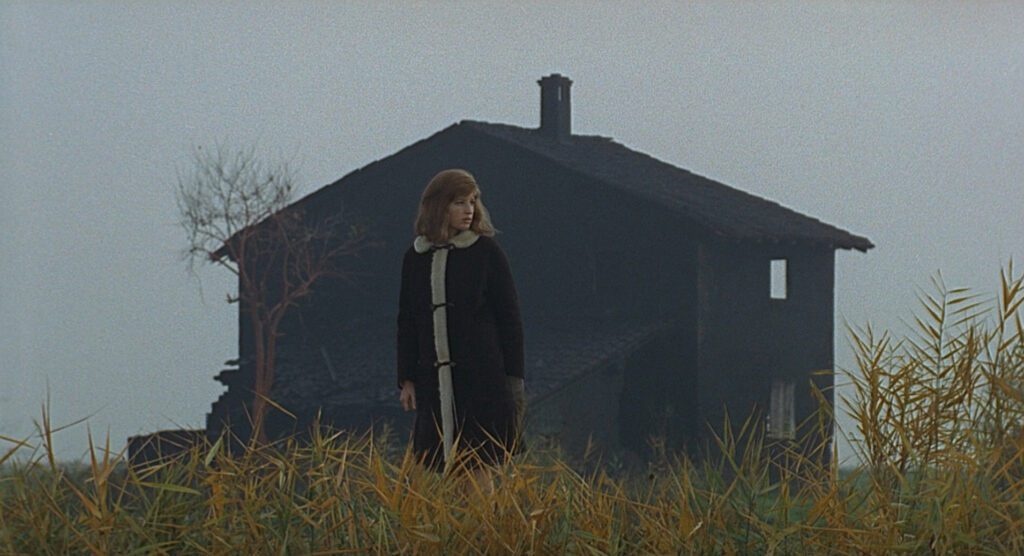
Red Desert was Antonioni’s first color film, and he uses colors to characterize both the setting and Giuliana’s state of mind. Entire fields were specially painted, and factory emissions were tinted yellow. Giuliana steps outside her shop to find everything gray, even the ashen face and wares of a street vendor, reflecting her distaste with life. After Corrado rapes her, everything in his hotel room turns the color of flesh, externalizing the revolting carnality of her experience. The distorted colors play the same role as the distorted settings in The Cabinet of Dr. Caligari, evoking the inner reality of a character unable to see things as they are. As with Caligari and most great films about mental illness, the benefit is not only for the patient – it’s intended for anyone watching. Looking at Red Desert in its broadest sense, Giuliana stands for the inhabitants of a modern world that has drifted apart from both nature and tradition.
All the abstract photography, intermittent blurriness, and distorted colors might seem to imply that the modern world interferes with a clear vision of reality, but Red Desert also reminds us how modern technology extends our vision, allowing us to see transparent fish at the bottom of the ocean, bacteria in a microscope, and possibly extraterrestrials in distant star systems. These enhancements to our vision can bring us wonder and progress, but they can also distract us from our natural spheres. Life, death, love, family, and home all begin to look foreign.
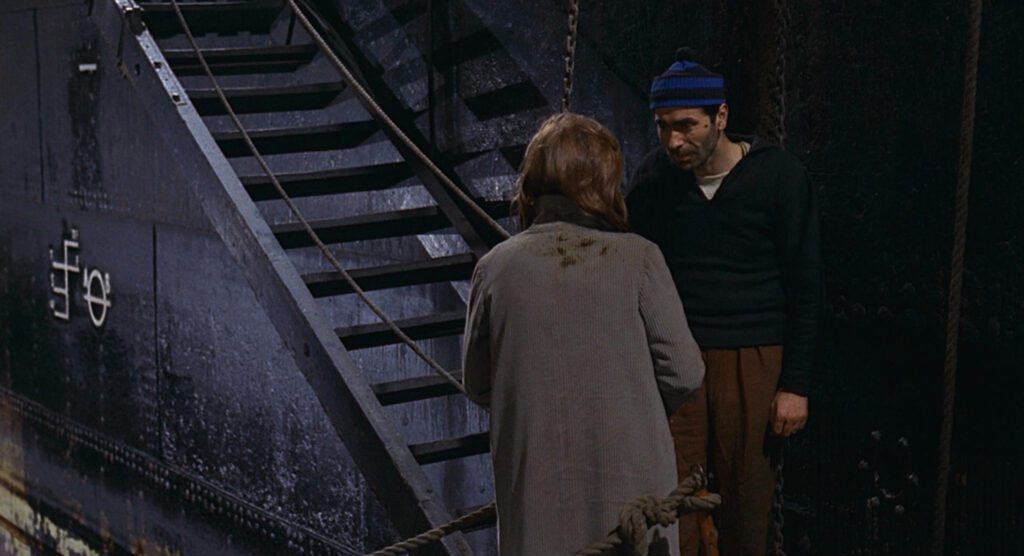
Speaking to Corrado about her accident, Giuliana invents a girl in the hospital to describe what she had felt and thought afterward. She had became preoccupied with the question “Who am I?” In the last minutes she comes to realize that that was the wrong question. Even under the best circumstances it’s forced, meaningless, and impossible to answer. After leaving Corrado behind the last time she finds herself at the docks speaking with a Turkish sailor. Neither can understand a word of the other’s speech, and that somehow frees her not only to speak freely but also to turn the question around. Her answer comes in a flash: “Everything that happens to me is my life.” This might sound banal until we realize that the converse assertion is more widely held – most people define their lives only by the highlights, their triumphs and joys, discounting their sorrows, tediums, traumas, and humiliations. Giuliana suddenly realizes that all her sufferings, the accident, her illness, and the last night with Corrado, are part of her life too, and that they don’t diminish who she is.
Giuliana’s epiphany is the climax of Red Desert, and in it she makes peace with reality. Even if she doesn’t recover or become “normal”, her new understanding represents an adjustment to the world, which is a kind of health. Her seemingly unremarkable words to that Turkish sailor should have the status of an immortal movie line, but still no words alone can carry the full thrust of Red Desert if we appreciate it fully. The key lies in what is probably its most memorable scene, about twenty minutes earlier.
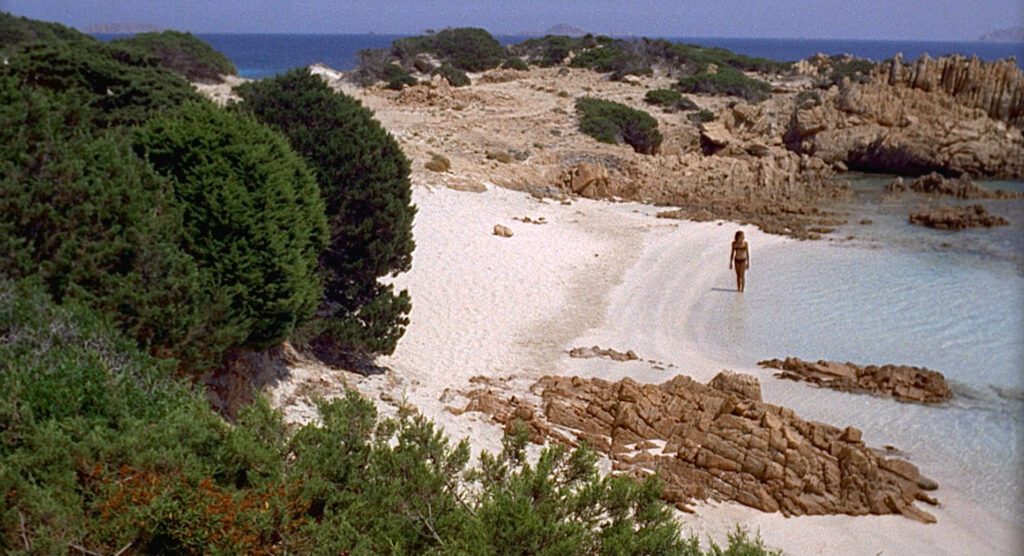
When Giuliana’s son Valerio goes inexplicably limp in his bedroom, she comforts him with a story. She says she has told him all the stories she knows, so this one must have sprung from the currents in her mind, the same way a dream sometimes tells us what we need to know. It appears to cure Valerio, and it will likely do just as much to restore Giuliana. The story is about a girl swimming at a pink beach who one day encounters a large sailing ship. She’s impressed and swims out to meet it, but she finds it steering itself with no one on board. When she gets back to shore a disembodied voice like an invisible siren fills the air with a beautiful wordless song. She looks in vain for its source. Valerio also wants to know, but Giuliana tells him it comes from “everywhere”.
The key to this fable is hidden because Giuliana passes it off so nonchalantly, yet it’s the quality that sets the girl apart. After encountering the phantom ship she swims back to the beach. “She was used to people’s strange ways and was not surprised.” The girl never tries to rationalize the mystery or fight it; she simply accepts it with childlike innocence, and nature rewards her by singing to her.
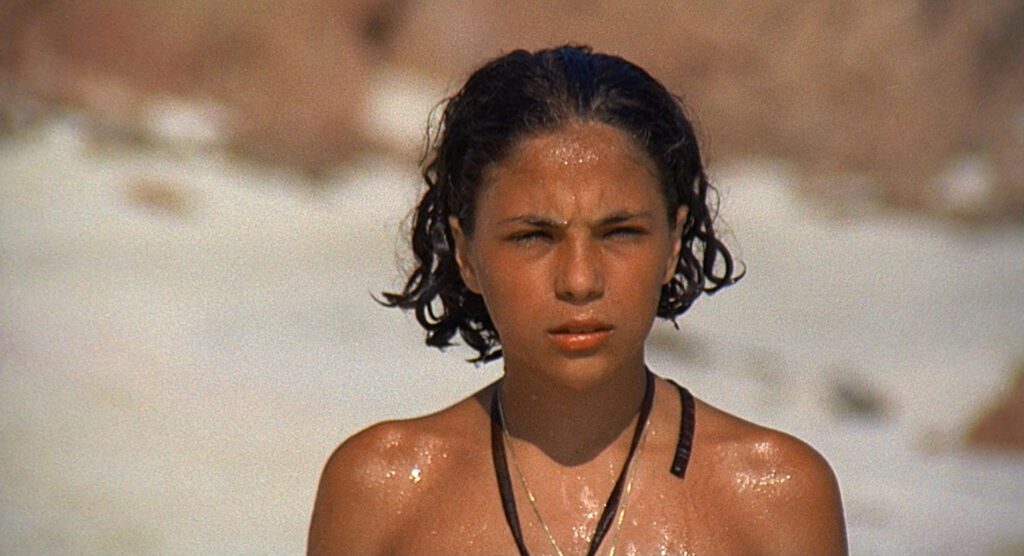
Giuliana’s fable of the girl on the pink beach is a lesson on the virtue of wonder. It defines an attitude to life, and at the same time it tells us how to watch Red Desert. Most people watching a movie they cannot understand will immediately dismiss it, but the same movie, if it’s well made, will “sing” to someone who views it with wonder. Having created this fable, Giuliana is ready to approach her own life with the same spirit. If she accepts her whole life as it is – not as she wants it to be, not the version that makes her the heroine of her story – then the world she lives in, even a world of refineries and factories, will begin to sing.
CONNECTIONS:
The Cabinet of Dr. Caligari – Distorted settings representing disturbed character’s point of view; lesson not limited to pathological cases
City Lights – Bracketed by images that describe an arc of increasing vision (one going from long shot to close-up, the other from blurry to focused)
Juliette, or the Key of Dreams – Experience as the substance of life
Hiroshima mon amour – Reconciliation and identification with an unhappy experience
Plein soleil – External world reflects internal states
Knife in the Water – Protagonist tells a story that secretly refers to self in the third person
An Autumn Afternoon – Smokestacks in opening shots; portrait of the modern world and its difficulties
Seconds – Idea that a person’s life is the result of all past experiences
Blow-Up – Accepting a mystery (phantom ship / tennis ball) leads to expanded vision; character enveloped in wonder hears sounds (wordless song / sounds of park) no one else can hear
The Man Who Left His Will on Film – Woman who discovers a sense of wonder in spite of rape and hardship
The Passenger – Protagonist tells a story that is secretly autobiographical (girl in hospital / blind man)
Nostalghia – Line about adding one drop of liquid to another resulting in a single drop